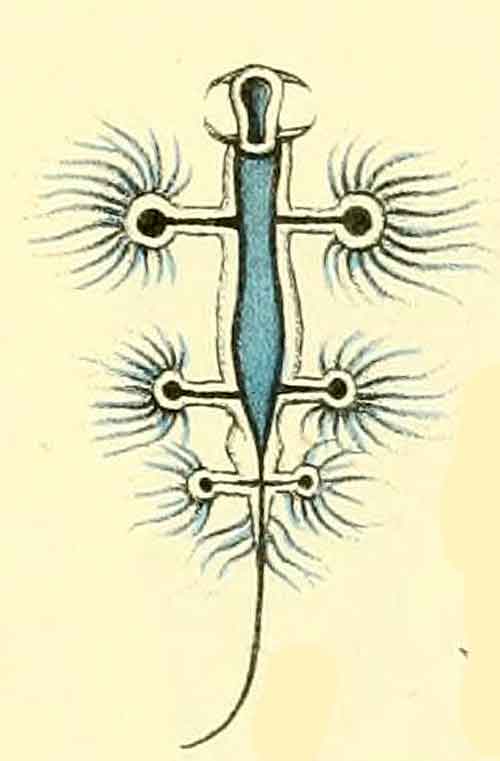Superregnum: Eukaryota
Cladus: Unikonta
Cladus: Opisthokonta
Cladus: Holozoa
Regnum: Animalia
Subregnum: Eumetazoa
Cladus: Bilateria
Cladus: Nephrozoa
Cladus: Protostomia
Cladus: Spiralia
Cladus: Lophotrochozoa
Phylum: Mollusca
Classis: Gastropoda
Subclassis: Heterobranchia
Infraclassis: Euthyneura
Cohors: Ringipleura
SuperOrdo: Nudipleura
Ordo: Nudibranchia
SubOrdo: Cladobranchia
Superfamilia: Aeolidioidea
Familia: Glaucidae
Genus: Glaucus
Species (1): G. atlanticus
Name
Glaucus Forster, 1777
gender: masculine
Type Species: Glaucus atlanticus Forster, 1777
References
Forster, G. 1777. A voyage round the world in His Britannic Majesty's sloop, Resolution, commanded by Capt. James Cook, during the years 1772, 3, 4, and 5. Vol. 1, pp. i–xviii, 1–602; vol. 2, pp. 1–607. Reference page.
Churchill, C.K.C.; Valdés, Á.; Foighil, D.Ó. 2014: Molecular and morphological systematics of neustonic nudibranchs (Mollusca: Gastropoda: Glaucidae: Glaucus), with descriptions of three new cryptic species. Invertebrate systematics, 28(2): 174–195. DOI: 10.1071/IS13038 Reference page.

Glaucus atlanticus
Glaucus is a genus of small blue pelagic sea slugs. They are aeolid nudibranchs,[1] ranging in size from 20 to 40 mm (0.79 to 1.57 in).[2] They feed on colonial cnidarians such as Portuguese man o' wars, blue buttons, and purple sails. They can produce painful and potentially dangerous stings when handled, as they store the venomous nematocysts of their prey.[3] Glaucus is the only genus in the family Glaucidae. It includes five species.[1]
Taxonomic history
The genus Glaucus was established by monotypy in 1777 by the British naturalist Johann Reinhold Forster.[4] He described specimens of Glaucus atlanticus recovered during the second voyage of James Cook aboard HMS Resolution. The genus is named after the Greek sea-god Glaucus.[5][6] In 1848, the German naturalist Johannes Gistel provided the substitute name Dadone for Glaucus. But it is unnecessary and is now regarded as invalid.[7]
The family Glaucidae was established in 1827 by the British zoologist John Edward Gray to contain the genus.[8] A second species in the family was described by the Danish malacologist Rudolph Bergh in 1860. He placed it under a new genus Glaucilla.[9] However, the synapomorphies between Glaucus and Glaucilla have made the maintenance of both genera irrelevant. Therefore Glaucus is now regarded as the only genus within the family Glaucidae.[10] Glaucidae is classified under the superfamily Aeolidioidea.[8]
In 2014, a careful DNA and anatomical study of the genus unexpectedly revealed the presence of a species complex. Only one species was found in the Atlantic, but the name Glaucus marginatus was revealed to include four separate species (referred to informally as the 'marginatus' clade). There are three species in the North Pacific Subtropical Gyre System and another species in the South Pacific Subtropical Gyre System. Glaucus atlanticus also occurs throughout the Indo-Pacific as well as in the Atlantic Ocean. In the North Pacific are Glaucus marginatus, Glaucus thompsoni and Glaucus mcfarlanei, with Glaucus marginatus also occurring in the Indian Ocean and the South Pacific. Also in the South Pacific is Glaucus bennettae.[4][11]
Glaucus atlanticus has some genetic differences in different parts of its range but is considered to be a single species.[12]
Species
Species within the genus Glaucus include:
Glaucus atlanticus Forster, 1777 – Atlantic Ocean
Glaucus bennettae Churchill, Valdés & Ó Foighil, 2014 – South Pacific
Glaucus mcfarlanei Churchill, Valdés & Ó Foighil, 2014 – North Pacific
Glaucus marginatus (Bergh, 1860) – Indo-Pacific
Glaucus thompsoni Churchill, Valdés & Ó Foighil, 2014 – North Pacific
Species brought into synonymy
Glaucus distichoicus d'Orbigny, 1837: synonym of Glaucus atlanticus Forster, 1777
Glaucus flagellum Blumenblach, 1803: synonym of Glaucus atlanticus Forster, 1777
Glaucus hexapterigius Cuvier, 1805: synonym of Glaucus atlanticus Forster, 1777
Glaucus lineatus Reinhardt & Bergh, 1864: synonym of Glaucus atlanticus Forster, 1777
Glaucus longicirrhus Reinhardt & Bergh, 1864: synonym of Glaucus atlanticus Forster, 1777
References
Bouchet, P.; Gofas, S. (2013). Glaucus Forster, 1777. Accessed through: World Register of Marine Species on 2013-07-17
Aly, N. (16 June 2011). "Glaucus atlanticus & marginatus". Suba Diver Life. Retrieved 23 September 2015.
Stromberg, J. (12 April 2012). "Glaucus atlanticus: Science Picture of the Week". Smithsonian.com. Retrieved 23 September 2015.
Churchill, C. K. C.; Valdés, Á & Foighil, D. (2014). "Molecular and morphological systematics of neustonic nudibranchs (Mollusca : Gastropoda : Glaucidae : Glaucus), with descriptions of three new cryptic species". Invertebrate Systematics. 28 (2): 174–195. doi:10.1071/is13038. S2CID 84010907.
Forster, G. (1777). A voyage round the world in His Britannic Majesty's sloop, Resolution, commanded by Capt. James Cook, during the years 1772, 3, 4, and 5 by George Forster. Vol. 1. White, Robson, Elmsly & Robinson. p. 49.
Scocchi, C. Wood, J.B. (ed.). "Blue Ocean Slug (Glaucus atlanticus)". Marine Invertebrates of Bermuda. The Cephalod Page. Retrieved 23 September 2015.
Bouchet, P. (2015). Dadone Gistel, 1848. Accessed through: World Register of Marine Species on 2015-09-23
Bouchet, P. (2013). Glaucidae. Accessed through: World Register of Marine Species, Glaucidae Gray, 1827, Glaucus Forster, 1777 on 2014-06-11
Bergh, L.S.R. (1860). "Om Forekomsten af Neldefiim hos Mollusker". Videnskabelige Meddelelser fra den naturhistoriske Forening i Kjöbenhavn. 1860: 309–331.
Valdés, Ágel & Campillo, Orso Angulo (2004). "Systematics of pelagic aeolid nudibranchs of the family Glaucidae (Mollusca, Gastropoda)". Bulletin of Marine Science. 75 (3): 381–389.
Churchill, C.K.; Alejandrino, A.; Valdés, Á. & Foighil, D. (2013). "Parallel changes in genital morphology delineate cryptic diversification of planktonic nudibranchs". Proceedings of the Royal Society B: Biological Sciences. 280 (1765): 20131224. doi:10.1098/rspb.2013.1224. PMC 3712456. PMID 23825213.
Churchill, C.K.; Valdés, Á. & Foighil, D. (2014). "Afro-Eurasia and the Americas present barriers to gene flow for the cosmopolitan neustonic nudibranch Glaucus atlanticus". Marine Biology. 161 (4): 899–910. doi:10.1007/s00227-014-2389-7. S2CID 84153330.
Retrieved from "http://en.wikipedia.org/"
All text is available under the terms of the GNU Free Documentation License

